Keep your pickled vegetables extra crispy with these proven techniques. Start by cutting your vegetables uniformly to guarantee even pickling. Add fresh grape leaves, which contain natural tannins that lock in crunchiness. Give your veggies an ice bath for 3-5 hours before pickling to firm them up. Select only the freshest, firmest produce at peak ripeness. Perfect your salt ratio by using a 2-4% concentration and pre-salting for 12-24 hours. Skip the heat processing and opt for refrigeration instead. Master the cold pack method by packing sanitized jars tightly without compression. These time-tested methods will transform your pickling game from amateur to expert.
Cut Vegetables Uniformly
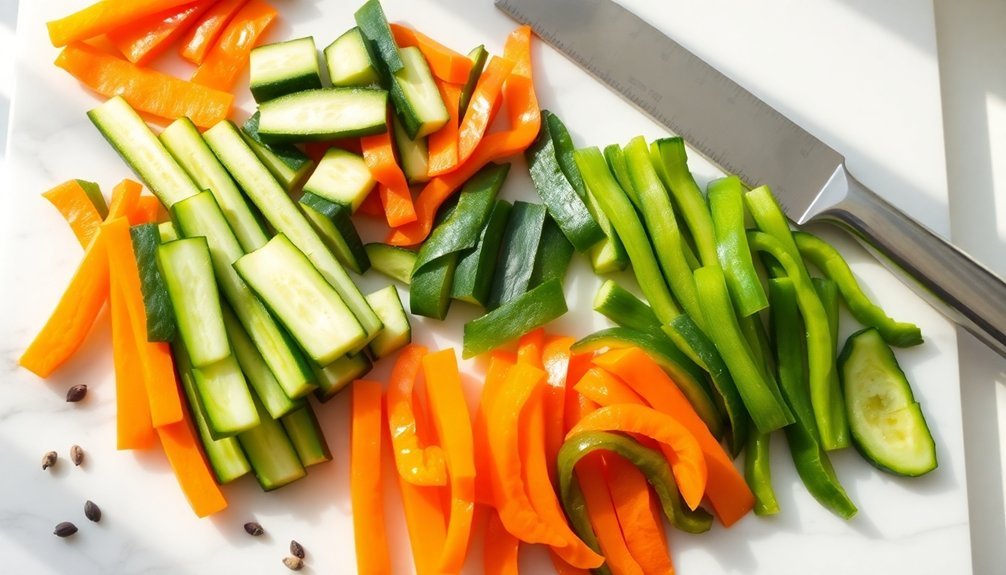
Before starting your pickling process, cutting vegetables uniformly isn't just about aesthetics – it's crucial for achieving consistent crispiness. When vegetables are cut into different sizes, they'll pickle at varying rates, leading to inconsistent textures throughout your batch.
You'll want to master several cutting techniques to guarantee uniformity. Using a damp cloth underneath your cutting board will keep it stable while you work. If you're working with larger vegetables, try batonnetting – cut them lengthwise, then into 1/4-inch strips, and finally into 2-inch pieces.
For more delicate preparations, julienning creates matchstick-sized pieces about two inches long and one-eighth inch wide, perfect for quick pickling.
For smaller, cube-shaped pieces, dicing is your go-to method. Start by cutting your vegetables into julienne strips, then make crosswise cuts to create uniform cubes.
If you're dealing with harder vegetables like carrots or celery, the paysanne technique works well – trim the vegetable to your desired length, then make thin, horizontal cuts perpendicular to the length.
Remember to keep your knife sharp, as clean cuts help maintain the vegetable's cell structure, contributing to better crispiness in your final pickled product.
Add Fresh Grape Leaves
Now that you've mastered the art of uniform cutting, adding fresh grape leaves to your pickling mixture will help maintain that perfect crunch.
These natural preservers contain tannins that inhibit the pectinase enzyme, which typically breaks down pectin in vegetables and causes them to soften.
You'll want to use about four small, fresh grape leaves for each batch of pickles. This method works particularly well with asparagus and other vegetables.
Make sure they're organically grown to avoid pesticide residues. You can use leaves from any grape variety, including table grapes, Concord, or wine grapes.
Simply place them at the top of your pickling jar to keep the vegetables submerged while releasing beneficial tannins into the brine.
If you can't find fresh grape leaves, you've got options.
Black tea leaves or oak leaves can work as alternatives, as they contain similar tannin properties.
You can also prepare for future pickling sessions by fermenting grape leaves in advance.
Just soak them in a basic brine solution and ferment for 3-4 days until they turn a dull green color.
Store these fermented leaves in your refrigerator for up to a year, and they'll be ready whenever you need them.
Ice Bath Before Pickling
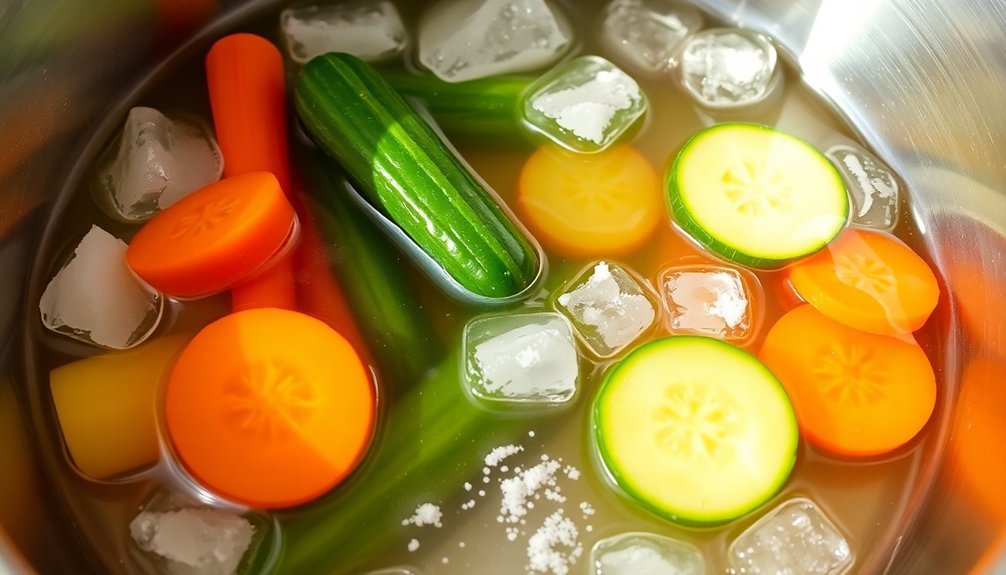
An ice bath creates a cold shock that firms up your cucumbers and other pickling vegetables, making them extra crispy before they hit the brine.
You'll want to control the size of your cut vegetables to guarantee even absorption during the 3-5 hour soaking period.
The timing of your ice bath matters greatly – while you can let vegetables soak overnight, a minimum of 3 hours is enough to rehydrate and prep them for the pickling process. Fresh morning harvest vegetables work best for achieving maximum crispness since they contain optimal moisture levels.
Cold Shock Effect
The cold shock method stands as an essential first step in preserving your vegetables' crispness during the pickling process. When you expose your vegetables to cold temperatures through an ice bath or crushed ice, you're effectively slowing down microbial activity and preventing enzyme activation that would otherwise lead to softening.
To implement the cold shock effect, you'll want to soak your vegetables in ice water for 4-5 hours or layer them with crushed ice. You can enhance this process by adding salt to your ice bath, which works synergistically with the cold temperatures to improve brine absorption later. The key is maintaining consistent cooling throughout the treatment.
The benefits you'll see are significant. Your vegetables will retain more water and maintain their pectin integrity, resulting in that sought-after crunch. They'll also absorb the pickling brine more effectively and maintain better color and appearance.
You can combine this method with other traditional techniques, such as adding grape leaves or calcium chloride, to maximize crispness. For both quick pickling and traditional methods, the cold shock effect will help guarantee your pickled vegetables stay fresh, flavorful, and satisfyingly crisp.
Duration Timing Matters
Building on the cold shock method's effectiveness, proper timing of your ice bath plays a central role in achieving perfectly crisp pickled vegetables. You'll want to plan for a minimum of three hours, though you can extend this to overnight if you're not ready to begin pickling immediately. This duration guarantees your cucumbers fully rehydrate after their journey from field to kitchen.
You'll get the best results by starting the ice bath process as soon as you've obtained your vegetables. Before submerging them, remove the blossom ends of your cucumbers, as this simple step enhances the effectiveness of the cold soak. Make certain you're using a container large enough to keep all vegetables fully submerged throughout the process.
Don't rush this essential step – the ice bath timing directly impacts the pectin structure of your vegetables, which you can't restore once it's compromised. The cold temperature inhibits pectinase enzymes that would otherwise break down the crisp texture.
If you can't maintain an ice-cold environment, you'll want to move your soaking container to the refrigerator to guarantee consistent temperature throughout the duration.
Vegetable Size Control
Proper size control stands at the forefront of achieving consistently crisp pickled vegetables. When you're preparing your vegetables for pickling, focus on cutting them into uniform shapes and sizes. This consistency guarantees that each piece will absorb the pickling brine evenly, resulting in a batch of perfectly pickled produce.
You'll want to cut your vegetables into rounds, slices, or spears, depending on your preference. Remember that smaller pieces will pickle faster than larger ones, so adjust your timing accordingly. By maintaining uniform sizes throughout your batch, you won't end up with some pieces that are over-pickled while others remain under-processed.
Start with fresh vegetables, as they'll provide the best foundation for crispy pickles. Fresh produce maintains its natural pectin structure, which is essential for that satisfying crunch.
Before you begin cutting, make sure you've selected vegetables that are recently harvested, as they'll have the highest potential for maintaining their crispness throughout the pickling process. The combination of proper sizing and fresh ingredients will greatly enhance both the texture and appearance of your finished pickles.
Use Fresh, Firm Produce
Fresh, firm produce serves as the foundation for successfully crispy pickled vegetables. The natural pectin in fresh vegetables is vital for maintaining crispness throughout the pickling process. Once vegetables become soft due to heat exposure or improper handling, you can't restore their firmness, so starting with just-picked produce is essential.
When selecting vegetables for pickling, you'll want to choose varieties specifically suited for the process. For cucumbers, pick ones no larger than 2 inches in diameter and don't forget to remove the blossom end to prevent softening. Always opt for vegetables at their peak ripeness to guarantee the best results.
Here's what you need to do with your fresh produce:
- Wash and dry thoroughly before starting the pickling process
- Process vegetables quickly to minimize exposure to heat and bacteria
- Use immediately after preparation – don't let them sit around
Handle your vegetables with care during preparation and packing to avoid damage. If needed, you can soak them in ice water to enhance crispness before pickling.
Perfect Your Salt Ratio
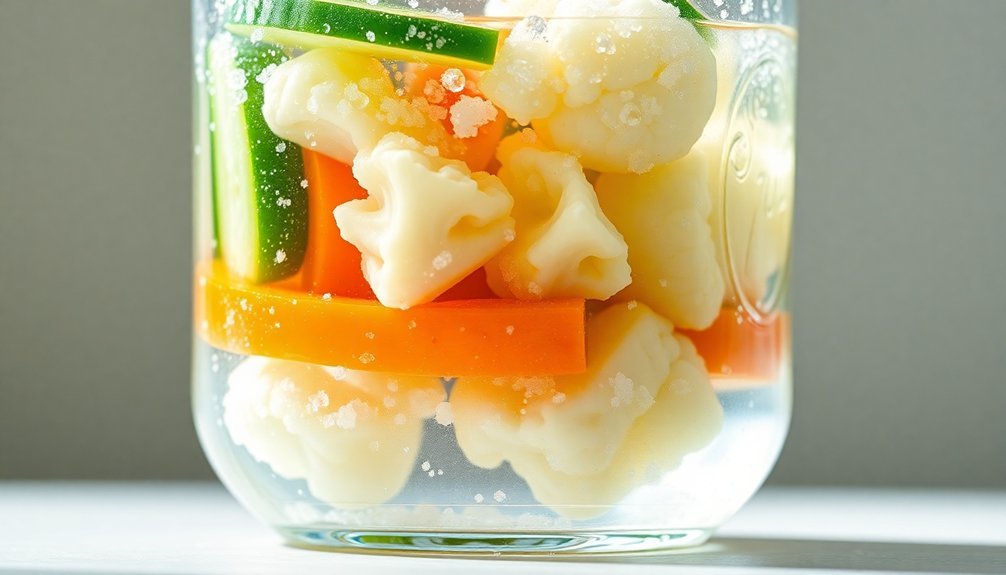
Perfecting your salt ratio starts with calculating the total salt concentration by weight, using specific percentages for different vegetables (2.0-4.0% TSC).
You'll get the crispiest results by pre-salting your vegetables for 12-24 hours before the main fermentation process begins.
For ideal crunch, try adding your calculated salt amount in two stages: half during pre-salting and the remaining portion when you pack the vegetables in the fermentation vessel.
Salt Concentrations By Weight
Mastering salt concentrations stands as the cornerstone of successful vegetable pickling.
You'll need to measure salt by weight rather than volume since different salt types vary in density – pickling salt, for instance, weighs twice as much as some kosher salt brands. Using a gram scale, you can precisely calculate the right amount: 2.5 grams of salt per 100 grams of vegetables.
For ideal crispiness and preservation, follow these concentration ranges:
- Use 2.0-2.5% TSC for softer vegetables like cabbage, garlic, and broccoli when you want faster fermentation.
- Choose 3.0-3.5% TSC for cucumbers, zucchini, and green beans to maintain moderate crunch.
- Apply 4.0% TSC or higher for peppers, with special cases like olives requiring up to 10%.
Your choice of salt concentration directly impacts the fermentation process and final texture.
Lower concentrations (2.0-2.5%) promote quicker fermentation but less crunch, while higher ranges (3.0-3.5%) help vegetables maintain their crisp texture and resist mold.
For long-term preservation, concentrations of 20-25% prevent all bacterial growth, though this is more for curing than fermenting.
Adding Salt At Intervals
Gradually adding salt at specific intervals during the pickling process helps achieve perfect fermentation and crunchiness. By distributing your salt additions over time, you'll maintain better control over the fermentation process and guarantee proper mineral concentration for the beneficial bacteria to thrive.
Start with a 2% salt solution and monitor your vegetables' progress. You can add more salt in small increments if needed, but don't exceed 5% total concentration, as this will halt fermentation. For best results, adjust your salt additions based on the vegetable type you're fermenting:
| Time Interval | Salt Amount | Purpose |
|---|---|---|
| Initial Brine | 2% solution | Create base environment |
| Day 2-3 | 0.5% addition | Boost beneficial bacteria |
| Day 4-5 | 0.5% if needed | Maintain crispness |
| Day 6-7 | 0.25% if needed | Fine-tune saltiness |
| Day 8+ | Test only | Monitor and adjust |
Remember to taste your ferment daily to gauge the salt level. If you're using additional crispness enhancers like grape leaves or calcium chloride, you can reduce your salt intervals slightly while maintaining the same beneficial effects on texture.
Pre-Salting For Extra Crunch
While adding salt at intervals helps control fermentation, pre-salting your vegetables creates an even stronger foundation for achieving maximum crunch.
You'll want to match your salt concentration to your specific vegetable type, using 2% for cabbage and onions, or 3% for cucumbers and summer squash. This initial brining process draws out excess moisture, particularly essential for water-rich vegetables like zucchini.
To pre-salt effectively, create a salt-water brine solution and soak your vegetables for several hours up to a day. This process helps preserve the natural pectin structure while preventing harmful bacteria from developing.
Remember to rinse your vegetables thoroughly after brining to remove excess salt before packing them into jars.
For best results during pre-salting:
- Use mineral-rich salt to support beneficial bacteria growth
- Calculate salt percentages based on total weight of vegetables and water (2-5% range)
- Remove blossom ends from cucumbers to prevent enzyme-related softening
Don't forget to pack your vegetables firmly but gently into jars after the pre-salting process. Crushing them will compromise their structural integrity and affect the final texture of your pickled products.
Avoid Heat Processing
When it comes to heat processing, careful consideration is needed since this traditional preservation method can affect pickle crispness. While you might be tempted to skip heat processing altogether, it's essential to understand that refrigerator pickles can pose safety risks, particularly from Listeria monocytogenes.
If you're looking to minimize heat exposure while maintaining safety, consider these validated alternatives:
| Method | Benefits | Considerations |
|---|---|---|
| Cold Pack | Maintains crispness | Must follow tested recipes |
| Quick Pickle | Fresh, crisp texture | Short shelf life |
| Refrigeration | Crunchier results | Safety concerns present |
| Modified Heat | Less softening | Requires precise timing |
| Small Batch | Better texture control | Limited quantity |
You'll need to carefully monitor any pickles that haven't been heat-processed for signs of spoilage. If you're using cold pack methods, stick to research-based recipes and current safety guidelines. While these techniques can help preserve crispness, they shouldn't compromise food safety. Remember that refrigeration temperatures must be maintained consistently if you're using cold methods, though this approach is still under scrutiny by food safety experts.
Master Cold Pack Method
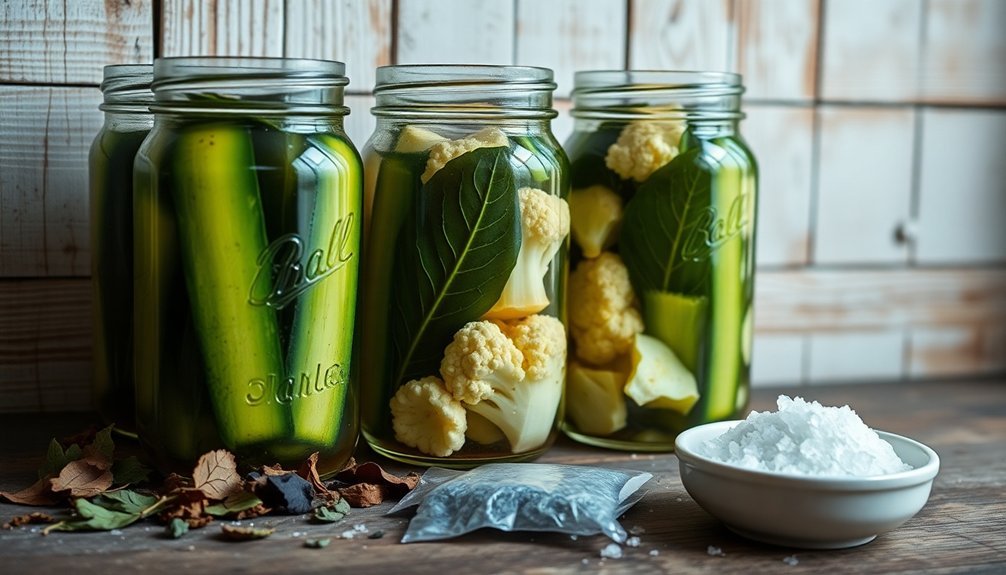
The cold pack method stands out as a superior technique for maintaining pickle crispness while working within safety parameters.
You'll need to start with fresh vegetables, washing them thoroughly under cold water and cutting them to the proper size – typically 1-inch slices for cucumbers and 1/2-inch pieces for carrots.
Begin by soaking your cut vegetables in ice water for 4-5 hours, ensuring they're covered with 2 inches of ice throughout the process.
While they're soaking, prepare your pickling liquid by combining 5% white vinegar, water, salt, and your chosen spices. Let this mixture cool completely to room temperature before use.
- Pack your sanitized mason jars tightly with the drained vegetables, but don't compress them so much that the brine can't circulate.
- Pour the cooled pickling liquid over the vegetables using a funnel, making sure to leave 1/2-inch headspace.
- Refrigerate immediately after sealing – no heat processing required.
This method preserves the vegetables' natural crunch while still ensuring food safety through proper acidification and refrigeration.
You'll find your pickles maintain their satisfying snap for weeks when stored properly in the refrigerator.
Frequently Asked Questions
Can Certain Spices Affect the Crispiness of Pickled Vegetables?
No, your spices won't directly affect pickle crispiness. While they'll enhance flavor, you'll need other methods like tannins, calcium chloride, or proper cucumber preparation to maintain that satisfying crunch in your pickles.
How Long Should Vegetables Soak in Lime Water Before Pickling?
You'll need to soak your vegetables in lime water for 12-24 hours. Make sure you're using food-grade lime and keep them fully submerged. Don't forget to stir occasionally for even distribution.
Does Vinegar Temperature Affect the Final Crunchiness of Pickled Vegetables?
Yes, vinegar temperature directly affects your pickles' crunchiness. You'll want to keep it below 185°F to prevent pectin breakdown. Use preheated water at 120-140°F for filling jars with your pickling brine.
Can Storing Pickled Vegetables Upside Down Help Maintain Their Crispiness?
No, storing your pickles upside down won't help maintain crispiness. You'll get better results by focusing on fresh vegetables, proper brining, and correct storage temperature rather than container orientation.
Why Do Some Pickled Vegetables Become Mushy Despite Following Preservation Methods?
Your pickled vegetables might become mushy due to inadequate acidity levels, improper storage temperature, using over-mature produce, or enzyme activity. Even a small mistake in these factors can affect the final texture.
In Summary
You'll find your pickled vegetables maintain that satisfying crunch when you follow these fundamental methods. From precise cutting to adding grape leaves, each technique plays a crucial role in preserving crispness. Remember, starting with quality produce and nailing the salt ratio makes all the difference. Whether you're new to pickling or a seasoned pro, these seven tips guarantee your preserves stay crispy and delicious.

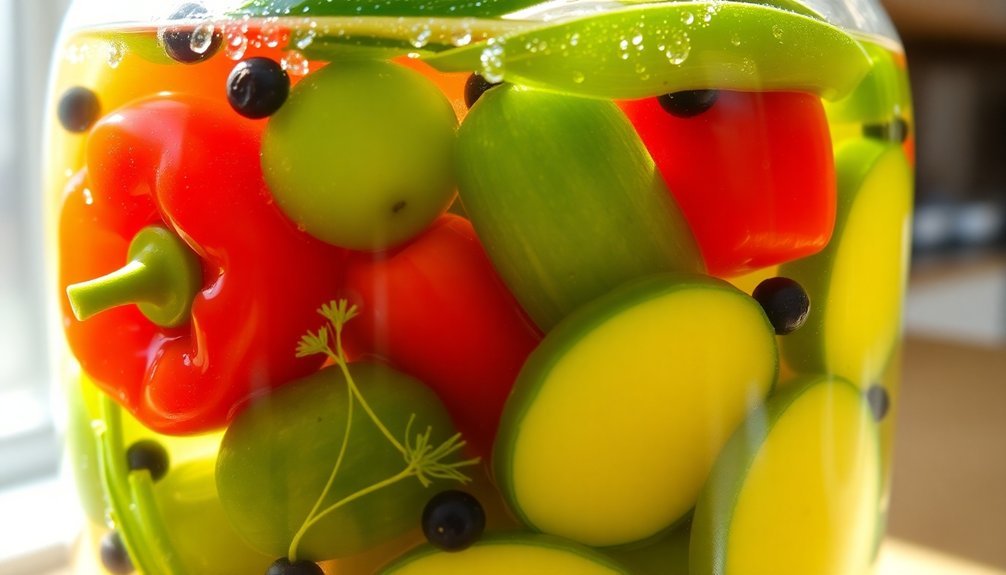



Leave a Reply